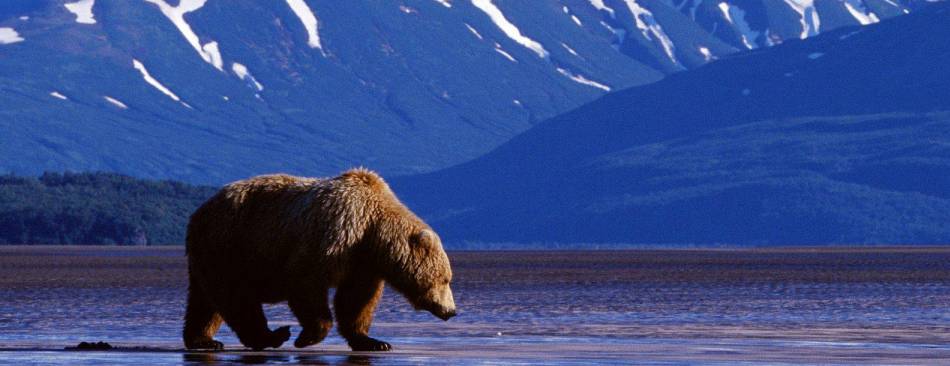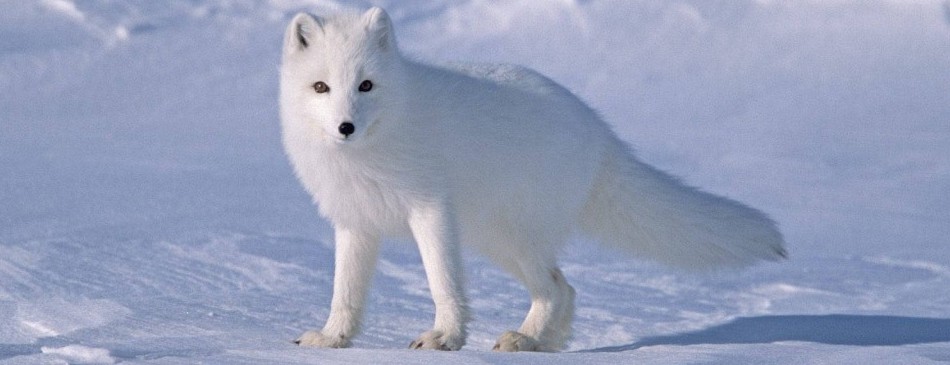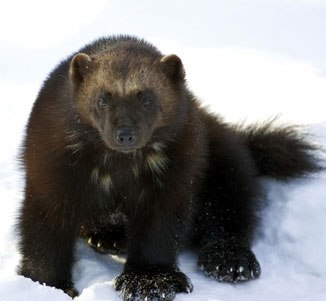The wolverine, also known as the “devil bear” and the
“woods devil,” is the largest and most ferocious member of the Mustelidae. Wolverines have long dense fur that is generally dark brown to black with a creamy white to gold stripe running from each shoulder along the flanks to the base of the tail. A white hair patch on the neck and chest is common. It has a thick body, short legs, short ears, and a broad flat head. Like humans and bears, wolverines walk on the soles of their feet, called semiplantigrade posture. They have curved, semi-retractile claws and can climb trees readily. They are well suited to travel through deep, soft snow.
Wolverines are usually very solitary animals, until it is time for breeding season. The season ranges from May through August. After mating the males stay close to the females, and she initiates the travel when it is time to move. Mates as well as all other wolverines communicate with vocalizations and scent marks. All members of the weasel family have scent glands.
The females usually give birth in March with litter size usually being 2-3 kits. At birth the kit’s fur is white. Wolverines are born with their eyes closed and teeth not even breaching the gums. At about 15 months of age, the males reach sexual maturity.
Other than humans, the wolverine’s only natural predators are mountain lions and wolves. It appears that few wolverines live longer than 5 to 7 years in the wild. Some, however, do survive to 12 or 13 years of age. The primary natural mortality factors are starvation, being killed by larger predators, primarily wolves, and by other wolverines. Wolverines are vulnerable to harvest and because of their limited reproductive capability can be sensitive to overharvest. Sustainable harvests in heavily trapped areas of Alaska depend on the presence of refugia as the source population of wolverines.
Wolverines prey on ground squirrels, snowshoe hare, moose, and caribou. They have even been known to prey on livestock and poultry. The wolverine population primarily depends on the abundance of rodents. Wolverines are better adapted for scavenging than for hunting and are opportunistic eaters. During winter, they primarily eat the carcasses of animals that have died of natural causes and the carcasses of moose and caribou left by wolves and hunters. The rest of the year their diet consists of smaller animals, such as voles, squirrels, snowshoe hares, and birds. On rare occasions, wolverines may kill moose or caribou
Wolverines are found throughout Alaska but there are areas that wolverines tend to avoid or exist at lower densities because the habitat is not suitable for denning or are highly developed or used by people. They are primarily solitary creatures throughout most of the year. Wolverine spatial patterns include: intersexual overlap, with home ranges of resident males overlapping those of 2-6 resident females; familial overlap, with offspring sharing their mother’s home range; and temporal exclusive intraspecific home ranges, with resident males defending their territories during February through July which coincides with the denning and breeding periods.
Wolverines are active at any time of day, year round. They have tremendous physical endurance. Movements of 40 miles in a day have been documented. They usually dwell in coniferous forests with territories ranging from 240 square miles to over 400 square miles. Humans hunted wolverines, as well as all other weasels, for their pelts which were mainly used for subzero condition jackets. The wolverine’s pelt is world famous because of its frost resistant properties.
Because of their great endurance, strength, and foraging behavior, wolverines have become a center of folklore. However, its fierce reputation has often been exaggerated. They are known to steal furbearers from traps and to damage cabins but contrary to stories will not attack a larger predator, like a wolf or a bear. Instead, they avoid these animals as encounters with either of these predators may be fatal to the wolverine. Wolverines will defend a food source or its territory against other wolverines or smaller predators.
The continued health of wolverine populations in Alaska is best assured by both protecting large expanses of wilderness and preventing overharvest. Preservation of their habitat is of key importance to their successful management. Much wolverine habitat is now protected in the state through various federal and state land dedication programs. However, as human recreational pursuits expand into more remote areas, greater protection of natal denning areas may become an important management issue.
|
|








